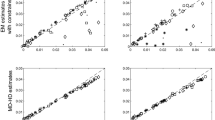Abstract
In the Basic Local Independence Model (BLIM) of Doignon and Falmagne (Knowledge Spaces, Springer, Berlin, 1999), the probabilistic relationship between the latent knowledge states and the observable response patterns is established by the introduction of a pair of parameters for each of the problems: a lucky guess probability and a careless error probability. In estimating the parameters of the BLIM with an empirical data set, it is desirable that such probabilities remain reasonably small. A special case of the BLIM is proposed where the parameter space of such probabilities is constrained. A simulation study shows that the constrained BLIM is more effective than the unconstrained one, in recovering a probabilistic knowledge structure.
Similar content being viewed by others
References
Albert, D. (Ed.) (1994). Knowledge structures. New York: Springer.
Albert, D., & Lukas, J. (Eds.) (1999). Knowledge spaces: theories, empirical research, applications. Mahwah: Lawrence Erlbaum.
Bertsekas, D. (1996). Constrained optimization and Lagrange multiplier methods. Belmont: Athena Scientific.
Dempster, A., Laird, N., & Rubin, D. (1977). Maximum likelihood from incomplete data via the em algorithm. Journal of the Royal Statistical Society, Series B, 39(1), 1–38.
Doignon, J.-P., & Falmagne, J.-C. (1985). Spaces for the assessment of knowledge. International Journal of Man-Machine Studies, 23, 175–196.
Doignon, J.-P., & Falmagne, J.-C. (1999). Knowledge spaces. Berlin: Springer.
Falmagne, J.-C., & Doignon, J.-P. (1988). A class of stochastic procedures for the assessment of knowledge. British Journal of Mathematical and Statistical Psychology, 41, 1–23.
Falmagne, J.C., Doignon, J.P., Koppen, M., Villano, M., & Johannesen, L. (1990). Introduction to knowledge spaces: how to build, search and test them. Psychological Review, 97(2), 201–224.
Goodman, L. (1974). Exploratory latent structure analysis using both identifiable and unidentifiable models. Biometrika, 61, 215–231.
Haberman, S. (1979). Qualitative data analysis (Vols. 1, 2). New-York: Academic.
Houseman, E., Coull, B., & Betensky, R. (2006). Feature-specific penalized latent class analysis for genomic data. Biometrics, 62(4), 1062–1070.
Junker, B.W. (2001). On the interplay between nonparametric and parametric irt, with some thoughts about the future. In A. Boomsma, M.A.J.V. Duijn, & T.A.B. Snijders (Eds.), Essays on item response theory (pp. 274–276). New York: Springer.
Junker, B., & Sijtsma, K. (2001). Cognitive assessment models with few assumptions, and connections with nonparametric item response theory. Applied Psychological Measurement, 25(3), 258–272.
Langeheine, R., Pannekoek, J., & van de Pol, F. (1996). Bootstrapping goodness-of-fit measures in categorical data analysis. Sociological Methods and Research, 24, 492–516.
Macready, G.B., & Dayton, C.M. (1977). The use of probabilistic models in the assessment of mastery. Journal of Educational Statistics, 2(2), 99–120.
Maris, E. (1999). Estimating multiple classification latent class models. Psychometrika, 64(2), 187–212.
Schrepp, M. (1997). A generalization of knowledge space theory to problems with more than two answer alternatives. Journal of Mathematical Psychology, 41(3), 237–243.
von Davier, M. (1997). Bootstrapping goodness-of-fit statistics for sparse categorical data: results of a Monte Carlo study. Methods of Psychological Research, 2(2), 29–48.
Wright, S. (1997). Primal-dual interior-point methods. Philadelphia: SIAM.
Author information
Authors and Affiliations
Corresponding author
Rights and permissions
About this article
Cite this article
Stefanutti, L., Robusto, E. Recovering a Probabilistic Knowledge Structure by Constraining its Parameter Space. Psychometrika 74, 83–96 (2009). https://doi.org/10.1007/s11336-008-9095-7
Received:
Revised:
Published:
Issue Date:
DOI: https://doi.org/10.1007/s11336-008-9095-7




